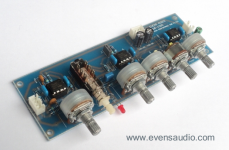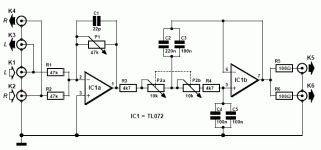hi,
i want to make a low apss filter for a 12inch subwoofer....
can you help me with a good working and simple circuit?
i want to make a low apss filter for a 12inch subwoofer....
can you help me with a good working and simple circuit?
An RC filter makes a single pole passive filter.
The series R gives impedance that resists the flow of music.
The shunting C gives a variable impedance as frequency changes.
At low frequencies the impedance given by the C is high and most of the music goes straight past it.
At high frequencies the impedance of the C is low and some of the music is shunted to ground. This reduces the amount of music passing to the next stage.
You can cascade a series of the passive RC filters to get steeper slopes than the single pole gives. But it gets very complicated taking account of how each filter affects the adjacent filters in the cascade.
An alternative is to separate the passive RC filters with active buffers so that each filter works independantly of the other filters in the cascade. There are Threads discussing this in detail.
A final alternative is to go to active filters using the amplifiying device to give feedback. The simplest of these is the Sallen and Key unity gain filter. Again there are Threads discussing these.
The RC mentioned at the beginning is a low pass filter.
Swapping the components to form a CR filter, changes it to a high pass filter.
The series R gives impedance that resists the flow of music.
The shunting C gives a variable impedance as frequency changes.
At low frequencies the impedance given by the C is high and most of the music goes straight past it.
At high frequencies the impedance of the C is low and some of the music is shunted to ground. This reduces the amount of music passing to the next stage.
You can cascade a series of the passive RC filters to get steeper slopes than the single pole gives. But it gets very complicated taking account of how each filter affects the adjacent filters in the cascade.
An alternative is to separate the passive RC filters with active buffers so that each filter works independantly of the other filters in the cascade. There are Threads discussing this in detail.
A final alternative is to go to active filters using the amplifiying device to give feedback. The simplest of these is the Sallen and Key unity gain filter. Again there are Threads discussing these.
The RC mentioned at the beginning is a low pass filter.
Swapping the components to form a CR filter, changes it to a high pass filter.
sub filter
Technical details
- Power supply + /-15VDC Power consumption less than 50mA.
- Switch to X10 magnification 10X with LED indicator.
- Subsonic filter circuits, HPF at 15Hz-150Hz.
- Adjustable overwhelmingly the response of HPF circuit by adding lower Q.
- Circuit LPF Cut-Off frequency is 60Hz-300Hz.
- Adjustable sliding phase 0-180 degrees.
- Electric Input impedance 47K Un-balance stereo.
- 1st channel's output impedance below 10 ohms.
- Gain 0dB / +20 dB switch controlled by switch😉
Technical details
- Power supply + /-15VDC Power consumption less than 50mA.
- Switch to X10 magnification 10X with LED indicator.
- Subsonic filter circuits, HPF at 15Hz-150Hz.
- Adjustable overwhelmingly the response of HPF circuit by adding lower Q.
- Circuit LPF Cut-Off frequency is 60Hz-300Hz.
- Adjustable sliding phase 0-180 degrees.
- Electric Input impedance 47K Un-balance stereo.
- 1st channel's output impedance below 10 ohms.
- Gain 0dB / +20 dB switch controlled by switch😉
Attachments
Are you prepared to do any of the work?....what aboyt the value of the resistor and the cap?
i want the sub to play untill 150 hz...
Panos1, It Richie00Boy's circuit is too complicated, you should consider one of the many kits on the market, such as the one andrewlebon linked to.
Richie's circuit is about as simple as is functional, (from left to right) mix the stereo signal, choose normal or inverted operation, adjustable filter and (optional) extra poles at 160 Hz to keep the high stuff out of the sub.
You should also consider high passing your mains in a complimentary fashion. From your intended cutoff, you are likely using small speakers that will distort badly if they are fed any bass. Try to protect them with a high pass and your sound quality will be better.
Rod Elliot (Elliot Sound Products) also has some useful circuits and boards available, but you need an inverting mixer like Richie's if you want to avoid crosstalk with a single sub.
Andrew also gave you a lot of information to help you decide what you really want to do and ways to learn about it. Simply typing "RC Filter Equation" into your favorite search engine is a good place to start learning how to answer the questions for yourself, rather than apparently asking to be spoon fed.
Richie's circuit is about as simple as is functional, (from left to right) mix the stereo signal, choose normal or inverted operation, adjustable filter and (optional) extra poles at 160 Hz to keep the high stuff out of the sub.
You should also consider high passing your mains in a complimentary fashion. From your intended cutoff, you are likely using small speakers that will distort badly if they are fed any bass. Try to protect them with a high pass and your sound quality will be better.
Rod Elliot (Elliot Sound Products) also has some useful circuits and boards available, but you need an inverting mixer like Richie's if you want to avoid crosstalk with a single sub.
Andrew also gave you a lot of information to help you decide what you really want to do and ways to learn about it. Simply typing "RC Filter Equation" into your favorite search engine is a good place to start learning how to answer the questions for yourself, rather than apparently asking to be spoon fed.
Thankyou
Thank you for a very clear explanation of a RC filter. Great post.
Thank you for a very clear explanation of a RC filter. Great post.
An RC filter makes a single pole passive filter.
The series R gives impedance that resists the flow of music.
The shunting C gives a variable impedance as frequency changes.
At low frequencies the impedance given by the C is high and most of the music goes straight past it.
At high frequencies the impedance of the C is low and some of the music is shunted to ground. This reduces the amount of music passing to the next stage.
You can cascade a series of the passive RC filters to get steeper slopes than the single pole gives. But it gets very complicated taking account of how each filter affects the adjacent filters in the cascade.
An alternative is to separate the passive RC filters with active buffers so that each filter works independantly of the other filters in the cascade. There are Threads discussing this in detail.
A final alternative is to go to active filters using the amplifiying device to give feedback. The simplest of these is the Sallen and Key unity gain filter. Again there are Threads discussing these.
The RC mentioned at the beginning is a low pass filter.
Swapping the components to form a CR filter, changes it to a high pass filter.
I post hundreds of great posts.
But and very unfortunately, these tend to contain a lot of script and don't get read because they are so long.
If I try to shorten to "cryptic", Members come back asking for a repeat of all the detail I have usual given before.
Thanks for the compliment and the support.
I get accused of being "unhelpful" !
But and very unfortunately, these tend to contain a lot of script and don't get read because they are so long.
If I try to shorten to "cryptic", Members come back asking for a repeat of all the detail I have usual given before.
Thanks for the compliment and the support.
I get accused of being "unhelpful" !
Last edited:
- Status
- Not open for further replies.
- Home
- Source & Line
- Analog Line Level
- low pass filter
![power_amplifier_tda2030_2.1_subwoofer[1].jpg](/community/data/attachments/345/345793-ad2b54362e327a74d998c08351000df5.jpg?hash=rStUNi4yen)

